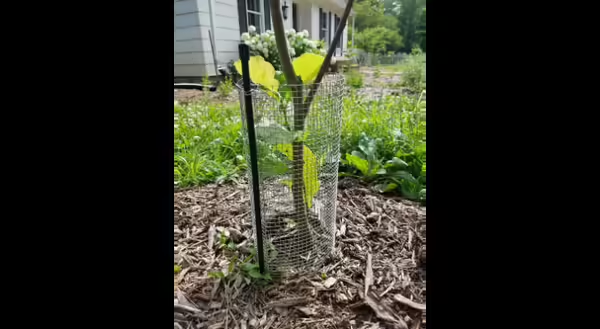
Fall is an excellent time to add new trees or shrubs to the landscape and many of us have already taken advantage of mild weather and sunny days to get new plants in the ground. With the lion’s share of work complete after digging, planting and mulching are finished, we often overlook some of the final steps to prepare new woody plants for winter.
Drought stress is the number one killer of newly planted trees or shrubs. While the coming winter months will certainly provide ample moisture and lower temps with less pressure from evaporation, don’t overlook the near-term absence of soil moisture. The last few weeks have been especially dry, which can be stressful on deciduous plants that are making the taxing transition to winter dormancy. Late season watering provides a much needed resource to your plant and conserves valuable root mass.
Remember, your new tree or shrub is in transplant shock until it can extend its roots beyond the initial planting hole. Don’t let newly planted root balls dry out before they have a chance to grow and extend their reach next spring. Winter weather will likely bring plenty of moisture to see your new plant through to spring, but don’t forget to add moisture as needed over the critical next few weeks. If in doubt, check soil moisture by gently removing mulch and feeling the soil. If it feels dry to the touch, take time to add some water.
No doubt you have already added mulch at planting time, but a lot may have happened since then. Mulch is surprisingly mobile in the environment, being easily moved by wind, rain, or scratching animals. This time of year I make the rounds, paying special attention to any newer plants, and do one last application of mulch prior to wintertime. A good mulch layer serves to preserve soil moisture and also acts as an insulating blanket to protect fragile fine roots from freezing.
Many of our furry friends like to give newly planted trees attention. Voles love a cozy, grassy area near tree trunks for winter protection and snacking on bark. However, rabbits are perhaps the biggest threat to new plants in my yard. From observation over the growing season, the local rabbit population in my neighborhood had a fruitful year. Similar to voles, rabbits love to chew bark, especially the thin bark on younger plants. This can be detrimental to the plant since all the conductive tissue (think of it being similar to veins and arteries in humans) for a woody plant is immediately inside the bark and even very minor nibbling can wreak havoc.
There are a number of ways to preclude winter snacking from rabbits and voles. Keep brushy materials and grass pulled away from trunks as it can create an inviting refuge. Consider a protective physical barrier for your favorite specimens and those plants that are attractive to winter browsing animals.. New Jersey tea (Ceanothus americanus) is one such plant, attracting enough rabbit attention last winter at my house that one plant was mowed entirely to the ground. It made a great rebound over the growing season, but I intend to curtail any winter feeding in coming months by installing a small cage to protect the plant.
I have found that metal hardware cloth is one of the best materials for rabbit and vole protection over winter. It is easily purchased in rolls at a variety of retail outlets and can be cut into smaller pieces to make cages around individual stems or entire plants, like my New Jersey tea shrub. Be sure to make your exclusion about 20 inches tall so a reaching rabbit cannot easily overtop the cage.
Aside from providing a physical barrier like this, it is incredibly important to keep tree trunks exposed to open air all the way down to the soil line. Don’t make the mistake of piling up mulch or other materials around trunks as this limits the natural function of lower trunk tissue and invite critters.
However, there is one caveat. Very thin-barked trees, such as maples and beeches, can be susceptible to sunscald in winter. This happens as cold tree stems are rapidly warmed by solar radiation on sunny days. The internal and external temperature difference can cause cracks in the bark, killing valuable conductive tissue that resides just underneath.
Protect thin-barked species by applying a trunk wrap for winter. There are a variety of products marketed as trunk wraps. I prefer paper-based products as they tend to breathe a bit, allowing some air exchange to reduce trapped moisture. Remember, you only need to block the sun’s rays, the wrap does not need to be water tight. Be sure to remove this wrap as freezing temperatures subside in spring.
Don’t forget these important steps to “tuck your plants in” for winter and ensure they have everything needed to spring back to life when the growing season begins next year.